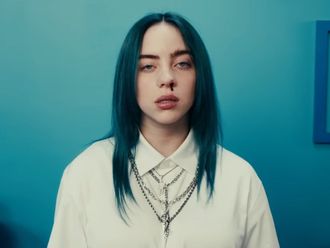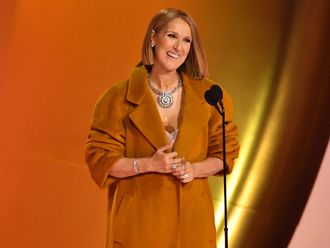
For several years, an introverted Canadian singer of Ethiopian descent, known to R&B lovers for his plaintive voice and atmospheric, after-party, comedown groove, has been on the cusp of becoming music’s next big thing. But each time stardom beckoned, Abel Tesfaye — a native of the dreary Toronto suburb of Scarborough, who sings, writes and produces as the Weeknd — seemed to demur. Only five years ago, Tesfaye, 25, was folding shirts at a Toronto outlet of American Apparel and posting audio tracks on YouTube. With the release this month of a second studio album, Beauty Behind the Madness, backed by a compelling single, Can’t Feel My Face, which has a groove and feel reminiscent of an updated Michael Jackson hit, any residual sense of anonymity could be about to be irrevocably lost.
Last week, the New York Times predicted that the new album’s “closest recent analogue” was Taylor Swift’s country-to-pop monster crossover hit 1989. “He’s on his way to becoming one of the biggest male pop stars in an era dominated by divas,” wrote Time pop critic Nolan Feeney.
Apple Music has put its as yet untested might behind the Weeknd, inviting him to perform at its recent launch. Max Martin, the Swedish producer behind the careers of Britney Spears, Kelly Clarkson, Katy Perry and most recently Swift herself, has added pop gloss to a genre known as PBR&B (from the hipster beer Pabst Blue Ribbon) an electronic-influenced subdivision of R&B that includes Frank Ocean and FKA twigs.
Meanwhile, Tesfaye has aligned himself with the fashion-orientated super race of women — Kendall and Kylie Jenner, Gigi Hadid and her sister (and Tesfaye’s rumoured girlfriend) Bella, Cara Delevingne and Karlie Kloss — who orbit close to Swift’s highly managed pop machine.
As of mid-July, the Weeknd had three songs in the US pop charts: Earned It, the ballad he wrote for the film Fifty Shades of Grey, Can’t Feel My Face and Love Me Harder, recorded with pop princess Ariana Grande.
“It’s a gentle seduction,” says Fifty Shades director Sam Taylor-Wood. “The thing with his voice and the way he is, he just pulls you in.”
But should we be comfortable with what he is he saying? In the video for Can’t Feel My Face, Weeknd ends up being consumed by flames.
“As a commentary on what is required for an artist to stay in the public eye in the 21st century it’s a little terrifying,” says cultural commentator Carol Cooper. “Self-immolation is what a great artist does, but nowadays everyone is so overstimulated, striving toward a peak of feelings. He’s painting a world of heightened stimulation — on everybody’s part.”
Seductive emptiness
Tesfaye, whose parents moved to Canada in the 1980s when Ethiopia was being torn apart by civil war, spoke Arabic at home as a child — and many say this influence can still be heard in his singing style. By some accounts, he was 17 when left home. He sold weed and shoplifted food. He took drugs and learned to seduce women. From this twilight existence — life in Scarborough was “like a Coen brothers movie”, he told the New York Times — came songs, fragments of songs or just moods of seductive emptiness.
In late 2010, Tesfaye began posting links to his compositions on Facebook. The posts went up with images of women; Tesfaye himself was not in the pictures. Even by his stage name, the Weeknd (the third “e” dropped to distinguish him from a local rock band), he was hard to find. He gave no interviews and performed no concerts. In 2011 he put out three mixtapes, House of Balloons, Thursday and Echoes of Silence. Unlike many, The Weeknd avoided sampling vintage soul or funk, but instead looked to bands such as Siouxsie and the Banshees, Cocteau Twins and Portishead. In the opinion of one Toronto reviewer, the songs were “chilly nocturnes from a night traveller”.
By avoiding conventional exposure, the Weeknd presented himself as a fully formed rock star from the outset. But it would be a mistake to misinterpret Tesfaye’s reticence as lack of ambition.
“He knew how to build mystique,” says Ben Rayner, pop critic of the Toronto Star. “By not playing the pop game, and letting the listener fill in the blanks, he achieved a substantial amount of success.” When Tesfaye finally broke his silence in 2013, he explained that he’d felt as if he had nothing to say. “I hated how I looked in pictures... I was very camera shy,” he told Complex magazine. “People like hot girls, so I put my music to hot girls and it just became a trend. The whole ‘enigmatic artist’ thing, I just ran with it.”
Anonymous sex, drugs, parties ... he wrote about the downside and isolation that follows the high. Thanks to what Rayner calls “creepy psychosexual narco content”, the Weeknd soon became known as the dark prince of emotional R&B. “He walked a fine line between celebrating excess and undercutting it with deep self-loathing. He let the listener fill in the blanks.”
But the Weeknd’s first step toward conventional pop success, 2013’s Kiss Land, failed to find an audience beyond critics and established fans. Perhaps it was too scatter-shot, with Tesfaye drawing from Stevie Nicks, Genesis and Phil Collins. “I find a sound and run with it,” he said. Given that others were already working the same cinematic vein — among them Frank Ocean — the Weeknd’s reticence started to look like a hindrance.
Enter the ghost of Michael Jackson. The late king of pop, who has always lurked in the Weeknd’s singing style, is brought to the fore on Beauty Behind the Madness. “These kids, you know, they don’t have a Michael Jackson,” he told the New York Times. “They don’t have a Prince. They don’t have a Whitney. Who else is there?”
Still, while Jackson and Houston had their share of dark impulses, these did not come to light until long after they had made it. More than two million downloads of Earned It (Fifty Shades of Grey) suggest there’s no downside to a little darkness. Can’t Feel My Face, with its synthy bass line reminiscent of Jackson, can only be interpreted as a song about cocaine — and was No 1 on the US Billboard chart last week.
There’s nothing unprecedented in these dark tones, of course. Jackson’s Billie Jean was, after all, about confused paternity; Barry Manilow’s Copacabana — also cited as an influence — was about showgirl Lola, her bartender lover and a mobster shooting.
Now the Weeknd is moving in fashion circles and close to Lee Daniels, producer of the hip hop TV drama Empire, there is likely to be no shortage of showbiz emotional damage to observe. “She was numb, and she was so codependent,” the Weeknd sings on one new track. “She was young, and she was forced to be a woman.”
But can he carry his old fans with him to the new world of pop success? Some suggest he is already Jackson of the Thriller/Bad era, at least in terms of self-projection. It’s a risk: anonymity worked well for him. “I felt I had to change who I was,” is all he’ll say.
“He got to where he’s at by not playing the pop game,” says Rayner. “It’ll be interesting to see what happens now he is playing it. It seems to be working — he’s just had three top 10 hits.”
To Cooper, Weeknd’s connection to Jackson is not merely superficial. In Trilogy, she points out, he was interested in the before-party, mid-party and after-party attitudes of young people in this lifestyle.
“He chose to look at it through an existential point of view. They’re both talking about spiritual emptiness, their perception that the world is not how it should be, and their inability to do anything about it.”












